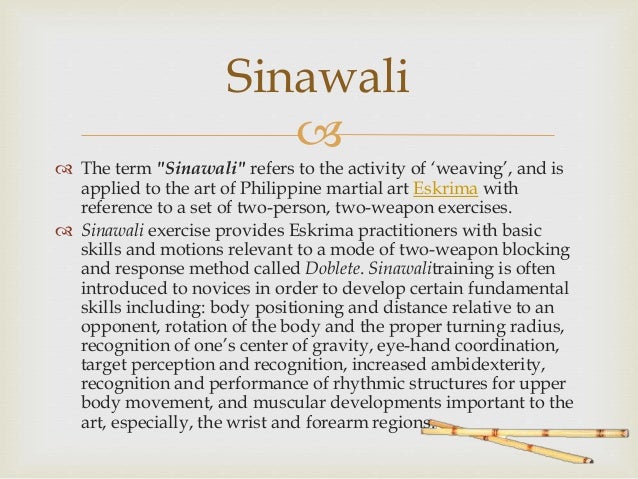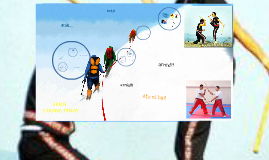Single Sinawali
❤️ Click here: Arnis single sinawali steps
When working Sak-Sak vs Bakal, make sure to remind the Sak-Sak person that they are aiming at targets, not the top of the stick where your hand is now if you are using the Bakal grip. The point to the clunky robotic-looking mess that some players make out of sinawali.

Only one person is executing the stabs, the other person is still continuing the normal single sinawali. June 5, 2015 at 9:29 pm Hi again Brian, good write-up. It is essentially a half-beat, it teaches simultaneous block strike as the right hand blocks down the left hand is attacking. This opened my mind to the possibilities that existed.

Single Sinawali - June 6, 2015 at 9:39 am Hi Fabian, Thanks for stopping by again and commenting! For example, Master Chuck Gauss emphasizes the 2 cane vs 1 cane single sinawali drill, inserting sweep strokes, and thrusts.

Single Sinawali The Basic Pattern is with two canes. Right Hand Strikes a number 1, then a number 8. Left Hand then Strikes a NUmber 1, then a Number 8. See for a description of the strikes. This pattern is also used in the Solo Baston Techniques and Drills. The Striking pattern is : Right Hand Strikes a Number 1 Then the Right hand strikes a number 8 Then the Right hand strikes a number 2 Then the Right hand strikes a number 9 This can be applied also with the left hand. Sure, there are many different exercises, principles and concepts, that can be applied within the single sinawali drill. Try to insert stabs in the sinawali. Only one person is executing the stabs, the other person is still continuing the normal single sinawali. Insert stabs from the outside: try to insert a stab number 10 with the right hand instead a strike number 1. The same on the other side, a left stab number 10 instead of a left strike 1. Insert stabs from the inside: after the 2 strikes with the right hand, the number one and 8, usually the strike 3rd strike is executed with the left hand as a left number 1. Instead of this, add a stab number 11 with the right hand and then strike the normal 4th, a number 8 with the left hand. Now the left hand stabs a number 11, followed by a right hand number 8. You see, now instead of the first 4 strikes being right high, right low, left high, left low, you changed to left high stab , right low strike , right high stab , left low strike. Then you have to find the way back to the normal single sinawali, which is too hard to describe via keyboard. Just try, I am sure you will find the way. You can combine the normal single with the single with thrust from the outside and inside, while your partner still plays the standard single Sinawali. Reversing the hands, also called the mirror principle. Normally, the right hands of the partners meet and then the left hands. Try to reverse this, by letting the left hand meet the right and vice versa. It goes like this: Still your partner continues to execute the normal singel sinawali. But you meet his first strike, the right number one with a left number 2, his right number 8 you meet with a left number 9. His left number 1 you meet with a right number 2 and his left number 8 you meet with the right number 9. You can continue this or follow the right number 9 with a right number 1 and you are back to normal single sinawali. Different hights, also called the complement principle. Try to meet the high strikes of your partner only with the right hand, while you meet the low strikes only with the left hand and then vice versa. It goes like this: right numnber 1, left number 9, right number 2, left number 8 and vice versa: left number 2, right number 8, left number 1, right number 9. There is much more you can do in single sinawali: The advanced single sinawali with or without stabs, the redondo concept, the half beats or off rhythem strikes with the right or left hand from the inside or the outside. And there are of course the single stick and empty hand applications of the single sinawali You can find the single sinawali with stabs in the Modern arnis brown belt video I offer, a lot of the other concepts you can find in the Sinawali video of Suro Mike Inay. If there is interest, I can show some of this during the symposium. I hope this helps a little. It is essentially a half-beat, it teaches simultaneous block strike as the right hand blocks down the left hand is attacking. I said hand but it can be stick, or knife, etc... Thanks Andy Originally posted by arnisandyz When the right hand does 1 then 8 - insert a lefthand 2 on the same beat as the 8, and vice versa for the left hand 9 - righthand 1. It is essentially a half-beat, it teaches simultaneous block strike as the right hand blocks down the left hand is attacking. I said hand but it can be stick, or knife, etc... Thanks Andy Click to expand... Moreover, as the left hand recovers to chamber on the left side, it can also be interpreted as blocking to the outside; as the right hand begins to chamber above the left hand, it follows an uppercut motion that can be used as a strike i. Best, Steve Lamade Click to expand... I have to disagree.... On the other hand I once saw Professor Wally Jay take ten minutes or so and break down the art of Judo strictly as a single siniwalli application or derivation. Humbling to say the least. Originally posted by dearnis. On the other hand I once saw Professor Wally Jay take ten minutes or so and break down the art of Judo strictly as a single siniwalli application or derivation. Humbling to say the least. I would have enoyed seeing that! I find some of the applications I've seen in Modern Arnis to be forced--attempting to fit it into single sinawali, like a square peg in a round hole. I don't think you're suggesting that it is. There's good stuff in there and a good lesson to be learned in extracting things from it, but I can't see in it some of the things others see in it. If it works for them, great! Going along with Datu Dieter, Here are some other cool variations from the book, Complete Sinawali by R. Galang 1 - 2 Follow through strikes R. This drill helps to introduce the Bakal grip to Single Sinawali. To work on getting comfortable with the Bakal group, try single sinawali using Bakal vs Bakal and Sak-Sak vs Bakal. When working Sak-Sak vs Bakal, make sure to remind the Sak-Sak person that they are aiming at targets, not the top of the stick where your hand is now if you are using the Bakal grip. Some people have a habit of targeting the top of the stick instead of their target and this behavior will get old really quick with this drill. Notice the subtle changes of range, angle, and body positioning. Please note the following for references: Sak-Sak - normal, natural, or hammer grip. Bakal - Reverse or ice-pick grip. Give it a shot, Palusut Because of the nature of disarms, a defender might obtain the opponents stick and have to use it with a Bakal grip. This drill helps to introduce the Bakal grip to Single Sinawali. To work on getting comfortable with the Bakal group, try single sinawali using Bakal vs Bakal and Sak-Sak vs Bakal. When working Sak-Sak vs Bakal, make sure to remind the Sak-Sak person that they are aiming at targets, not the top of the stick where your hand is now if you are using the Bakal grip. Some people have a habit of targeting the top of the stick instead of their target and this behavior will get old really quick with this drill. Notice the subtle changes of range, angle, and body positioning. Please note the following for references: Sak-Sak - normal, natural, or hammer grip. Bakal - Reverse or ice-pick grip. Give it a shot, Palusut Click to expand... I am asking because I see value in the grip for blade, but not stick. I could see value in doing sinawali's with it to work on blade translations of some sort, but I am having trouble seeing value in it for stick applications. A bakal grips could be a result mainly three scenarios: - A disarm of the opponent's stick. There are some systems that use it. Like anything else, it's good to work it in occassionally, so that you are familiar with it if you ever need it. Palusut Good questions Paul! A bakal grips could be a result mainly three scenarios: - A disarm of the opponent's stick. There are some systems that use it. Like anything else, it's good to work it in occassionally, so that you are familiar with it if you ever need it. Palusut Good questions Paul! A bakal grips could be a result mainly three scenarios: - A disarm of the opponent's stick. There are some systems that use it. Like anything else, it's good to work it in occassionally, so that you are familiar with it if you ever need it. Palusut advance single sinawali , advance single sinawali steps , definition of single sinawali , double sinawali , sinawali definition , sinawali steps , single and double sinawali , single sinawali , single sinawali arnis steps , single sinawali countings , single sinawali definition , single sinawali description , single sinawali meaning , single sinawali steps.
HOW TO SINGLE SINAWALI IN KALI
As alluded above, I teach four basic sinawalis at Bamboo Spirit Martial Arts: single, double, reverse, and heaven six sinawali. I would have enoyed seeing that. Nina 6, 2015 at 9:39 am Hi Fabian, Thanks for stopping by again and commenting. After a number of years, you will eventually dissolve the 2 vs. This drill helps to introduce the Bakal grip to Single Sinawali. Some people have a habit of targeting the top of the u instead of their target and this behavior will get old really quick with this drill.



